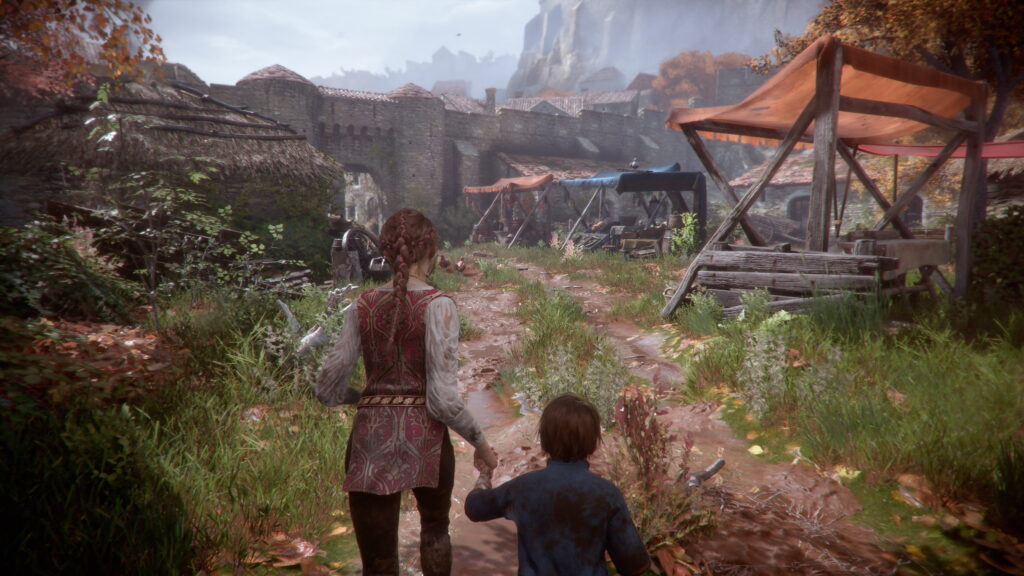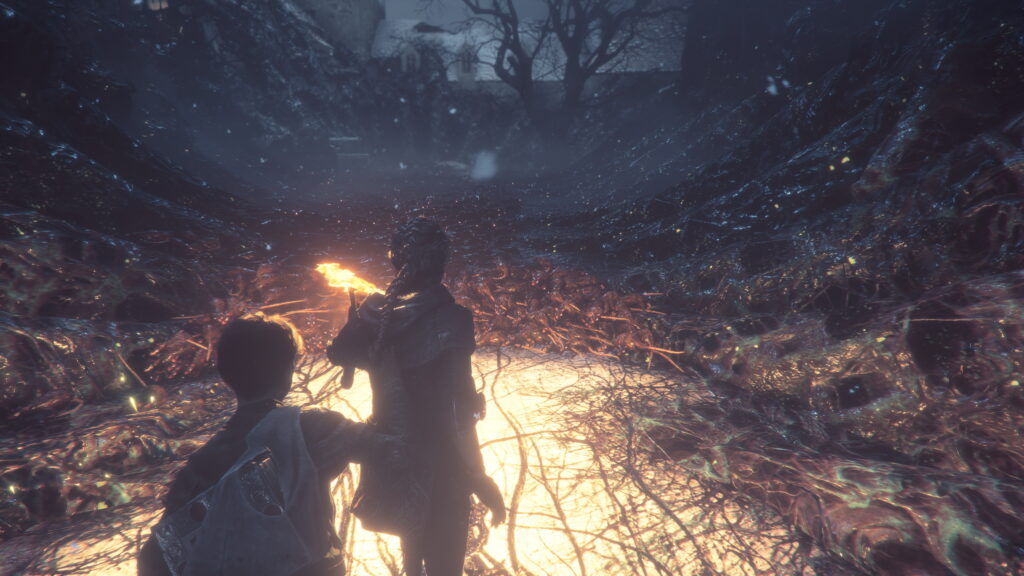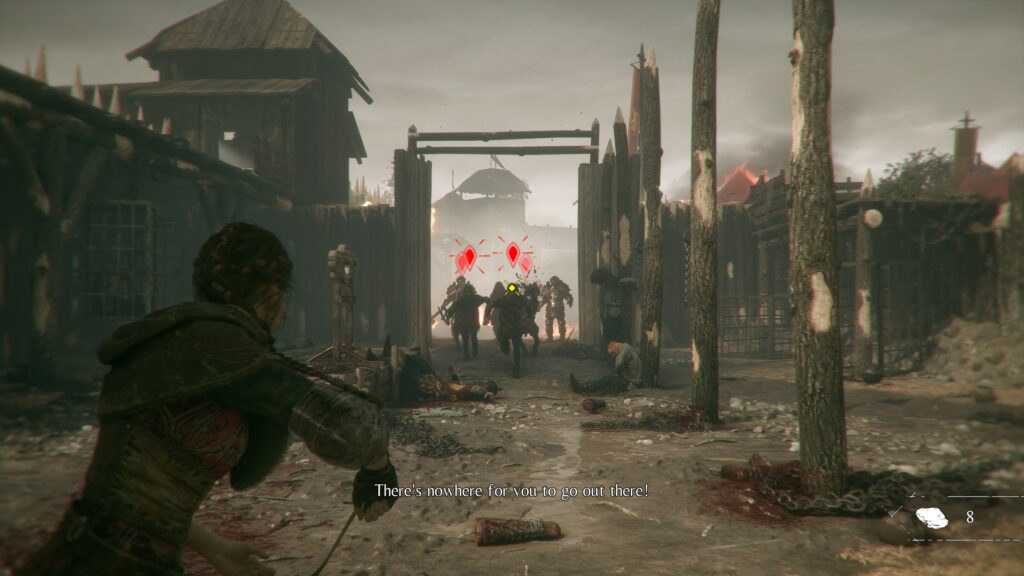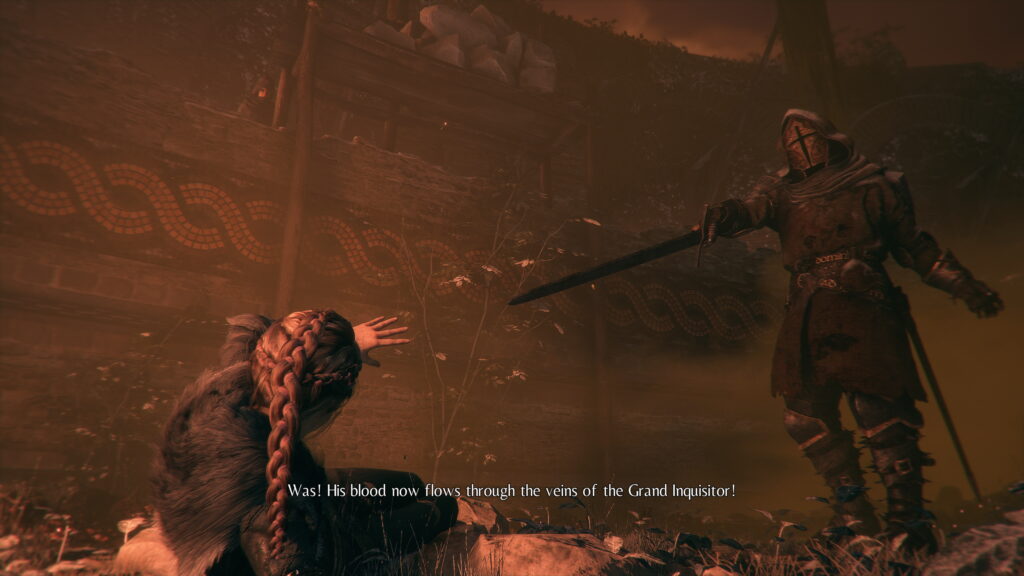
This was a free game on Epic and these days I choose to not even accept them if I know I’ll never play a title. This one attracted me due to it being set in 14th century France and ostensibly being about the black plague. I also believed that it would be a narrative-heavy, relatively short game with light gameplay mechanics. As it turned out these impressions were all incorrect. Instead this is a full-on stealth game with significant combat mechanics, is fairly substantial in length and the plague is represented only as the endless horde of rats that is your primary antagonist. I was miffed for a long while for not getting the game I expected but honestly the game is solid enough that it eventually managed to win me around anyway.
You play as Amicia de Rune, the daughter of a noble family during the time that we would now call the Hundred Years’ War. Amicia has a younger brother Hugo but as he was born with some strange illness, he is constantly being looked after by their mother Beatrice who is an alchemist. As a consequence she grows up having little contact with both. She does spend time with her father and develops impressive skills with her sling. One day their manor is attacked by soldiers apparently from the Inquisition who are looking for Hugo. Amicia watches her father get killed and obeys her mother’s instructions to guide Hugo out of the house and try to get him to another alchemist Laurentius. When she arrives at the nearby village, she finds that many of the villagers have succumbed to the Black Plague and that hordes of aggressive rats have appeared to attack everyone. When she makes it to Laurentius, he is himself sick and explains that Hugo is the bearer of a supernatural curse that runs in the de Rune bloodline. So Laurentius’ young apprentice Lucas joins this growing team of adolescents as they try to cure Hugo and keep one step ahead of the Inquisition, all the while battling endless waves of rats.

The game makes a fantastic first impression with its lush graphics and detailed depiction of a medieval world. All of the voices and animations are equally amazing and for a moment running through the village as Amicia trying to get help from the villagers for Hugo, it does feel as if this is a serious attempt to place the player in the midst of the real Black Plague. Unfortunately this is very much a supernatural fantasy story so you don’t actually have to fear for your characters getting sick and the plague itself is relegated to the background. You do have to fear the rats as they will swarm you and instantly eat you alive but there’s no gameplay mechanic for getting sick due to being bitten by rats. It would have been fascinating to play a game in which you have to deal with the mundane concerns of medicine, food and shelter while people all around you are dying of the plague but I had to make peace with the fact that this is indeed a very traditional video game. It even has boss battles and a big bad orchestrating all of the evil being done.
Gameplay-wise this is mostly a stealth game, though it has a strong dose of outright combat as well. Amicia essentially has no health so you instantly die the moment you are hit by any sort of attack. During the early parts of the game you and Hugo must sneak past the Inquisition guards hunting for you, hiding in tall grass, throwing stones and pots to distract them as needed. But Amicia can also kill guards with a stone from her sling provided they are not wearing helmets. As for the rat swarms, your weapon is fire. The rats are unable to enter any bright areas so carrying a torch makes you safe. Often however a torch is not available so you must light bonfires or move light sources around to make your way safely across a level. Later Amicia gains access to alchemical substances allowing her to light or extinguish fires from a distance, force a guard to remove his helmet, knock out a guard from behind and so on. One interesting mechanic is that Amicia has a companion with her most of the time and thus can make use of their abilities. Hugo for example is small and can wiggle through holes too small for Amicia to fit through, a thief companion can pick locks and a blacksmith companion is strong enough to take down guards by himself if he is able to take them by surprise.

One annoyance is that the game is really quite linear and so it is almost always very obvious when the game wants you to employ a particular ability for a particular situation. The puzzles which mostly involve manipulating light to get past the rats are similarly straightforward once you understand where it is you are meant to go. My Amicia still died a bunch of times however as timing can be crucial in some situations and it’s easy to underestimate how a single misstep can land you in a mess of rats. To add more of a challenge the game has a few traditional boss battles as well. While these aren’t exactly Dark Souls level of difficulty, they can still be a slog to get through as Amicia dies from just one hit so you must play things very, very safe. The upshot is that far from being a narrative-heavy game with only light game mechanics, this turned out to be an exceptionally videogamey video game.
That said, I did rather enjoy the game and the sense of being in this world. It’s downright crude how the game tries to get you to care for Hugo by needing Amicia to hold his hand almost all the time or else he will get a panic attack. But it does work and I ended up being invested in the motley crew of kids Amicia manages to gather to her. The characterizations and reactions of the kids are all solid and work well to advance the larger theme of adolescents needing to learn to fend for themselves and survive after they lose their parental figures. The plot about the evil conspiracy of the Inquisition is ridiculous but that’s only to be expected from the villains. At least we don’t spend too much time seeing things from the perspective of the bad guys.

One final point I’d like to make is that this game does suffer from a mismatch between its mechanics and the tone of its story. An obvious example is that there are collectibles in the game that you are encouraged to hunt and these offer up some nice nuggets of lore or extra characterization in the form of small interactions between the characters. Yet most of the time the characters are trying to run away or sneak past enemies. It’s absurd that they would take the extra time amidst this urgency to go looking in the nooks and crannies of the map. The same goes for the rats. Thinking of an actual rat plague makes them scary but when the game treats them as some kind of supernatural force amenable to the game mechanics, they’re much less so. This is why the really narrative-heavy game stick to adventure game style mechanics so that the actual story takes center stage.
Anyway I did grow to like the game despite it not being what I expected at first and despite it having rather ridiculous boss battles. The world that it creates and the characters that inhabit it are just that good. Plus even though I thought it would be cringey, having the game being all about a gang of kids in medieval France worked really well. For the price of free, this was a pretty great gaming experience. I am baffled that the studio that made this was also responsible for the current version Microsoft Flight Simulator. They seem like such radically different projects!